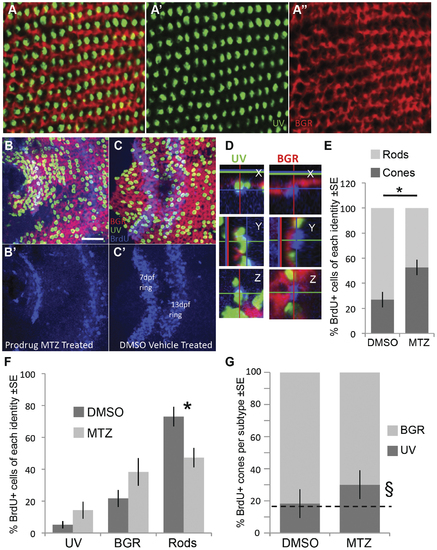Fig. 8
|
Following ablation of UV cones, the regenerating photoreceptors were more likely to become cones. Opsin riboprobe labelling to quantify the identity of regenerating cones: Throughout this figure, UV opsin riboprobe is green, and a cocktail of blue-, green- & red-opsin riboprobes are labelled in red. A. Post-larval areas of adult retina have the expected row mosaic pattern (see Figure 1) A′ & A′′ present individual riboprobes merged in A. B,C. Retinas labelled and oriented as per panel A (see also Figure 1), with BrdU located near the less-well-organized optic nerve head. Two rings of BrdU are visible marking cells that were dividing at the retinal periphery during BrdU application (7 & 13 days post fertilization, dpf, also shown separately in B′,C′). Only BrdU+ cells located between the two rings or inner to the 7 dpf ring were analyzed for co-localization with a photoreceptor subtype marker. Panel B is retina that had UV cones ablated by application of prodrug, panel C is control retina receiving vehicle control only. D. Magnified view of BrdU+ cells (blue) in three dimensions from images equivalent to panel B; images in panel B are presented in the ?Z view?. Cell in the left column was categorized as a UV cone because the UV opsin riboprobe label (green) is contiguous with the apical side of the BrdU+ nucleus. Cell in the right column was classified as a BGR (Blue, Green or Red cone) because the cocktail of these opsin riboprobes labels (red fluorescence) an area contiguous with the apical side of the BrdU+ nucleus. Apical is up in the X view, and to the left in Y view. E. As expected, most BrdU+ cells in control retina are rods, contrasting results following UV cone ablation by MTZ application, where the majority of BrdU cells are cones (* p = 0.008 by Kruskal-Wallis analysis of variance, N = 6 fish each in MTZ and DMSO vehicle control, equally divided amongst two trials). F. The number of BrdU+ cells per photoreceptor subtype (sub-dividing the results in panel E). Normal control retinas mostly generated rods, and the proportion of cone subtypes is coordinately but non-significantly increased. G. The relative abundance of BrdU+ UV cones, compared to other BrdU+ cone subtypes, did not increase significantly (p = 0.064) as assessed by a non-parametric analysis of variance per fish (N = 6). The proportion of UV cones matched the expected frequency of 16.7% (dotted line) in DMSO vehicle control treated fish (18.3%, χ2 p = 0.769, n = 84 BrdU+ cones), but was higher than the expected frequency following UV cone ablation when assessed as a sum of all fish (§, 30.1%, χ2 p = 0.0002, n = 311 BrdU+ cones in 6 fish). Overall, cone genesis increased following cone ablation, and future work is needed to determine the extent to which UV cones are more likely to regenerate relative to other subtypes following UV cone ablation. |
| Gene: | |
|---|---|
| Fish: | |
| Condition: | |
| Anatomical Term: | |
| Stage: | Adult |

